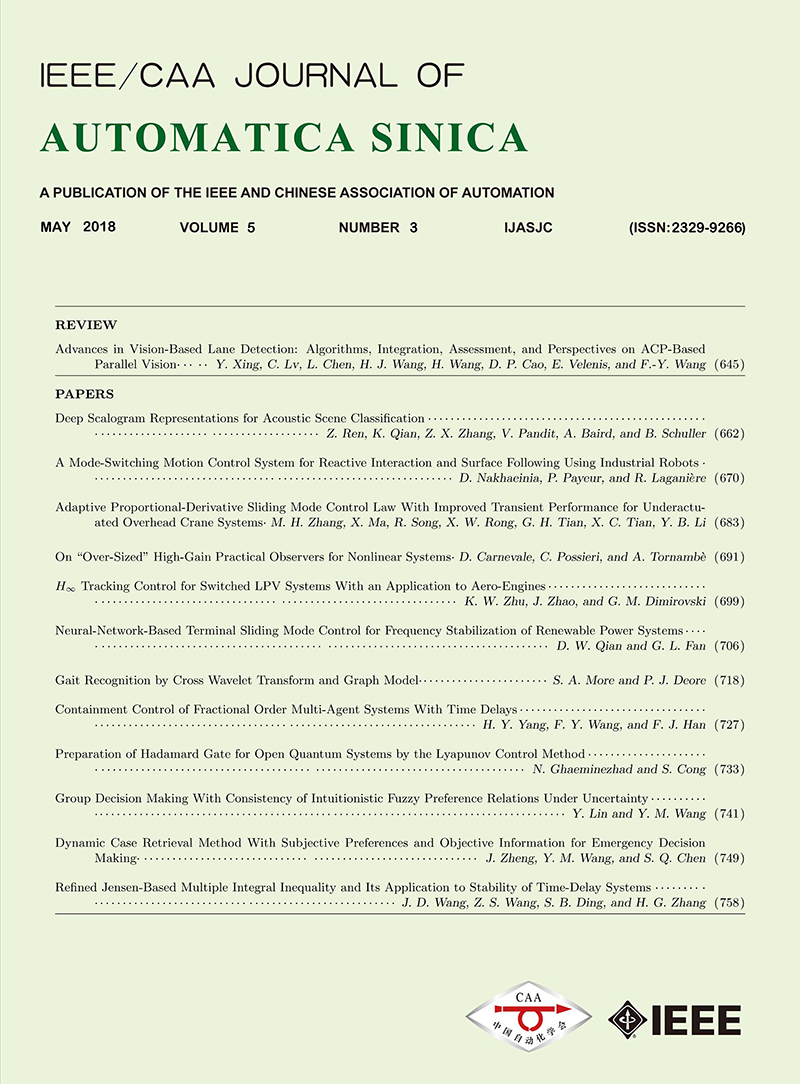 Volume 1
Issue 4
Volume 1
Issue 4
IEEE/CAA Journal of Automatica Sinica
| Citation: | Chao Ji, Jing Wang, Liulin Cao and Qibing Jin, "Parameters Tuning of Model Free Adaptive Control Based on Minimum Entropy," IEEE/CAA J. of Autom. Sinica, vol. 1, no. 4, pp. 361-371, 2014. |

| [1] |
Hou Z S, Huang W H. The model-free learning adaptive control of aclass of SISO nonlinear systems. In: Proceedings of the 1997 AmericanControl Conference. New Albuquerque, NM: IEEE, 1997. 343-344
|
| [2] |
Hou Z S, Jin S T. Model Free Adaptive Control: Theory and Application.Boca Raton: CRC Press, 2013.
|
| [3] |
Hou Z S, Jin S T. Data driven model-free adaptive control for a classof MIMO nonlinear discrete-time systems. IEEE Transactions on NeuralNetworks, 2011, 22(12): 2173-2188
|
| [4] |
Xu D Z, Jiang B, Shi P. A novel model free adaptive control designfor multivariable industrial processes. IEEE Transactions on IndustrialElectronics, to be published
|
| [5] |
Hou Z S, Wang Z. From model-based control to data-driven control:survey, classification and perspective. Information Sciences, 2013, 235:3-35
|
| [6] |
Wang J, Ji C, Cao L L, Jin Q B. Model free adaptive control and parametertuning based on second order universal model. Journal of CentralSouth University (Science and Technology), 2012, 43(5): 1795-1802
|
| [7] |
Astrom K J. Introduction to Stochastic Control Theory. New York:Academic, 1970.
|
| [8] |
Yue H, Wang H. Minimum entropy control of closed-loop trackingerrors for dynamic stochastic systems. IEEE Transactions on AutomaticControl, 2003, 48(1): 118-122
|
| [9] |
Deniz E, Jose C. An error-entropy minimization algorithm for supervisedtraining of nonlinear adaptive systems. IEEE Transactions on SignalProcessing, 2002, 50(7): 1780-1786
|
| [10] |
Petersen I R, James M R, Dupuis P. Minimax optimal control ofstochastic uncertain systems with relative entropy constraint. IEEETransactions on Automatic Control, 2000, 45(3): 398-412
|
| [11] |
Ma Y, Chen X, Xie X H. Research on MFA control algorithm withtracking differentiator. Chinese Journal of Scientific Instrument, 2009,30: 204-208
|
| [12] |
Chi R H, Hou Z S. A model free periodic adaptive control for freewaytraffic density via ramp metering. Acta Automatica Sinica, 2010, 36(7):1029-1033
|
| [13] |
Coelho L S, Pessôa M W, Sumar R R. Model free adaptive controldesign using evolutionary-neural compensator. Expert Systems withApplications, 2010, 37(1): 499-508
|
| [14] |
Yue H, Zhou J L, Wang H. Minimum entropy of B-spline PDF systemswith mean constraint. Automatica, 2006, 42(6): 989-994
|
| [15] |
Papoulis A, Pillai S U. Probability, Random Variables, and StochasticProcesses. New York: McGraw-Hill, 1991.
|
| [16] |
Zhuang M, Atherton D P. Tuning PID controllers with integral performancecriteria. In: Proceedings of the 1991 International Conference onControl. Edinburgh: IEEE, 1991. 481-486
|
| [17] |
Zhuang M, Atherton D P. Automatic tuning of optimum PID controllers.IEE Proceedings D, Control Theory and Applications, 1993, 140(3):216-224
|
| [18] |
Xu F, Li D H, Xue Y L. Comparing and optimum seeking of PIDtuning methods base on ITAE index. Proceedings of the Csee, 2003,23(8): 206-210
|
| [19] |
Jin S T, Hou Z S. An improved model-free adaptive control for a classof nonlinear large-lag systems. Control Theory & Applications, 2008,25(4): 623-626
|
| [20] |
Narendra K S, Parthasarathy K. Identification and control of dynamicalsystems using neural networks. IEEE Transaction on Neural Networks,1990, 1(1): 4-27
|